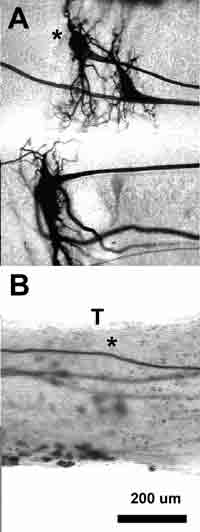Andrew McClellan
Andrew McClellan
PhD, 1980 Case Western Reserve University
Spinal cord injury and neural networks that control locomotor behavior
(A) Three brain neurons labeled with biocytin that regenerated their axons. (B) Axon (*) in the spinal cord from brain neuron in “A” (marked with “*”) that regenerated through a spinal cord transection site (T).
My laboratory uses the lamprey, a “lower” vertebrate, to study two general aspects of the neural systems that control locomotor behavior: (a) how locomotor networks in the brain and spinal cord operate in normal animals; and (b) the cellular and molecular factors that govern functional axonal regeneration and behavioral recovery following spinal cord injury. The lamprey is an excellent model system for studying locomotor systems. First, the nervous system is comparatively simple but shares many of the basic features of the nervous systems in higher vertebrates, including humans. Second, intracellular recordings are easily made from individual brain and spinal cord neurons, some of which are large and uniquely identifiable. Third, locomotor activity patterns can be generated in isolated nervous system preparations, which provide a number of very powerful technical advantages. Finally, unlike “higher” vertebrates, the lamprey exhibits robust axonal regeneration following spinal cord injury that results in virtually complete recovery of locomotor behavior within a few weeks. Thus, our work on functional regeneration in spinal cord-transected lamprey may provide insights into the mechanisms and requirements for successful axonal regeneration in higher vertebrates, including humans.
We are using a number of approaches to study fundamental issues regarding the locomotor systems in normal and spinal cord-injured lamprey:
- functional and anatomical studies of animals with spinal cord injury to determine the mechanisms for axonal regeneration and recovery of locomotor function;
- studies of the morphology, membrane properties, expression of ion channels (in collaboration with Dave Schulz), and synaptic specificity of injured brain neurons during axonal regeneration;
- cell culture of isolated brain neurons to discover the conditions and factors that promote neurite outgrowth and synapse formation and that may be important during axonal regeneration following spinal cord injury;
- computer modeling of brain neurons in normal and spinal cord-transected animals;
- cellular, synaptic, pharmacological, neuronal mapping, and computer modeling studies of locomotor networks in the brain and spinal cord of normal lamprey; and
- calcium imaging methods for monitoring neural activity patterns in large populations of brain and spinal cord neurons that control locomotor behavior.
Outstanding Undergraduate Mentor Award 2010
Sigma Xi Graduate Mentoring 2000
Gold Chalk Award 1997

